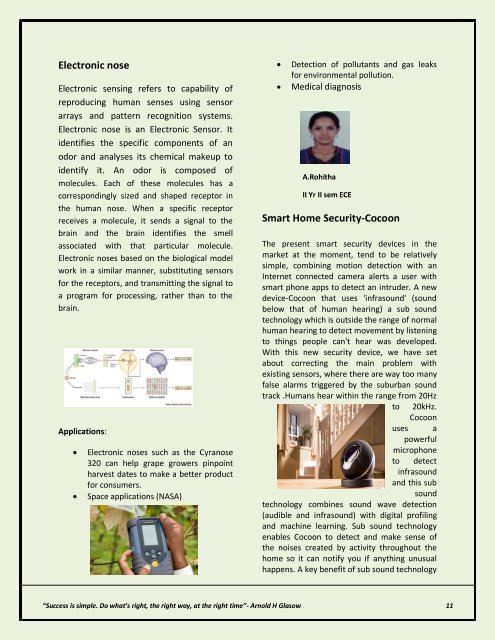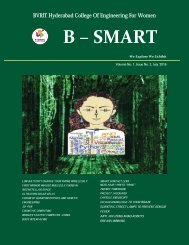merged_document
Create successful ePaper yourself
Turn your PDF publications into a flip-book with our unique Google optimized e-Paper software.
Electronic nose<br />
Electronic sensing refers to capability of<br />
reproducing human senses using sensor<br />
arrays and pattern recognition systems.<br />
Electronic nose is an Electronic Sensor. It<br />
identifies the specific components of an<br />
odor and analyses its chemical makeup to<br />
identify it. An odor is composed of<br />
molecules. Each of these molecules has a<br />
correspondingly sized and shaped receptor in<br />
the human nose. When a specific receptor<br />
receives a molecule, it sends a signal to the<br />
brain and the brain identifies the smell<br />
associated with that particular molecule.<br />
Electronic noses based on the biological model<br />
work in a similar manner, substituting sensors<br />
for the receptors, and transmitting the signal to<br />
a program for processing, rather than to the<br />
brain.<br />
Applications:<br />
<br />
<br />
Electronic noses such as the Cyranose<br />
320 can help grape growers pinpoint<br />
harvest dates to make a better product<br />
for consumers.<br />
Space applications (NASA)<br />
<br />
<br />
Detection of pollutants and gas leaks<br />
for environmental pollution.<br />
Medical diagnosis<br />
A.Rohitha<br />
II Yr II sem ECE<br />
Smart Home Security-Cocoon<br />
The present smart security devices in the<br />
market at the moment, tend to be relatively<br />
simple, combining motion detection with an<br />
Internet connected camera alerts a user with<br />
smart phone apps to detect an intruder. A new<br />
device-Cocoon that uses 'infrasound' (sound<br />
below that of human hearing) a sub sound<br />
technology which is outside the range of normal<br />
human hearing to detect movement by listening<br />
to things people can't hear was developed.<br />
With this new security device, we have set<br />
about correcting the main problem with<br />
existing sensors, where there are way too many<br />
false alarms triggered by the suburban sound<br />
track .Humans hear within the range from 20Hz<br />
to 20kHz.<br />
Cocoon<br />
uses a<br />
powerful<br />
microphone<br />
to detect<br />
infrasound<br />
and this sub<br />
sound<br />
technology combines sound wave detection<br />
(audible and infrasound) with digital profiling<br />
and machine learning. Sub sound technology<br />
enables Cocoon to detect and make sense of<br />
the noises created by activity throughout the<br />
home so it can notify you if anything unusual<br />
happens. A key benefit of sub sound technology<br />
“Success is simple. Do what’s right, the right way, at the right time”- Arnold H Glasow 11








